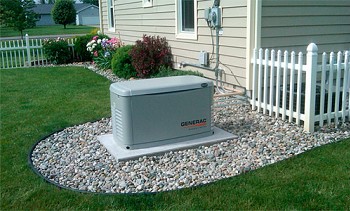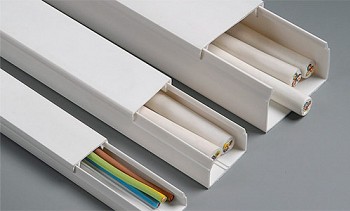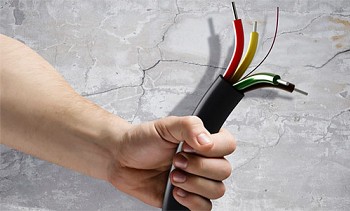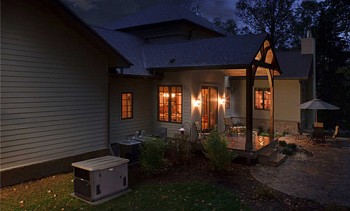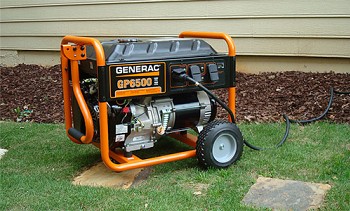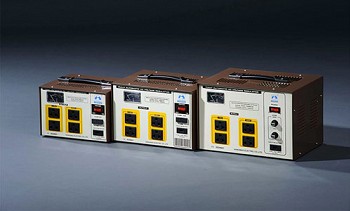Connecting a generator to the network of a country house: schemes and methods of connection
Depending on the model of the autonomous power supply device and the layout of the input shield, the connection of the generator to the network of a country house may differ slightly in detail. There are known differences between manual start and automatic, the nuances of connecting one and three-phase generators, but in general, with minimal skills in working with electrical circuits, everything can be done independently. Well, if you understand the principles of operation of the electromagnetic starter and relay, you can set up autorun and a conventional generator, which in another case would have to be constantly turned on with a key.
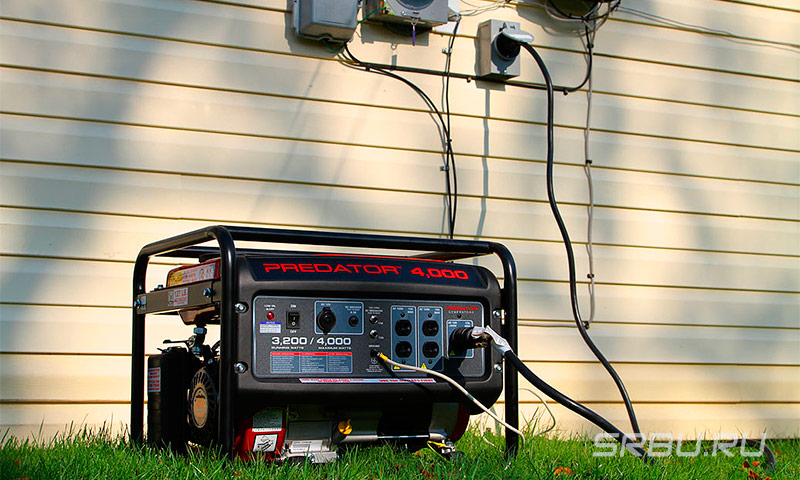
Content:
"Emergency" connection methods and their disadvantages
Usually, “fire” methods are used in cases where for some reason it is impossible to use the generator directly - you need to include it in your home network urgently, and there is no time to mount a separate connection scheme.
A specialist is distinguished from a simple layman, among other things, by his knowledge of the reasons for the prohibitions - this is what allows them to get around at the right moments: to do something not according to the rules, but to get the desired result. Just do not forget the banalities - electricity does not forgive mistakes, which means that you need to calculate your actions several steps forward to exclude all possible overlays.
Connection via a power outlet
The most common of the "fire" ways to connect the generator to the house is to banally plug it into a power outlet, for which a "carrying" with plugs at the ends is bought or manufactured on its own.
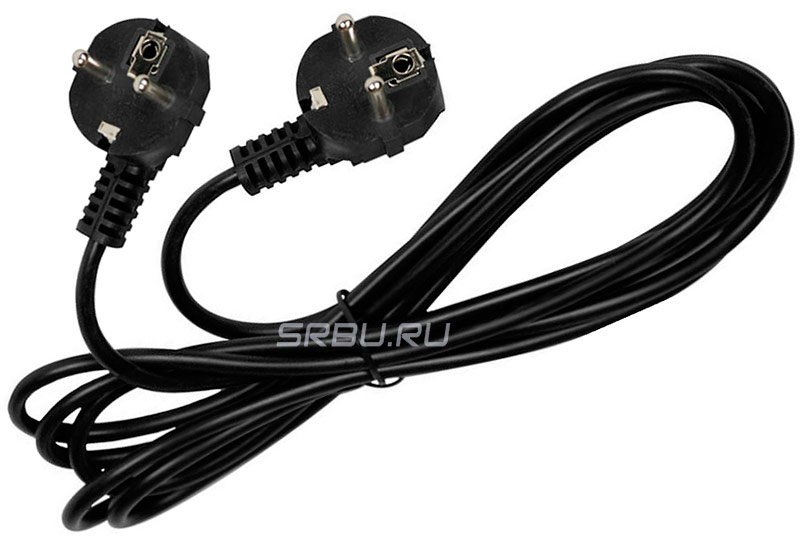
It is strongly discouraged to use this method, but the ease of use over and over again captivates many owners of small and medium power generators.
The principle of using such a connection becomes clear if you look at the standard home wiring diagram. Indeed, if a current source is connected to one of the outlets, then the voltage will appear in all parts of the circuit.

1. Introductory machine. 2. Electricity meter. 3. The generator. 4. Distribution machine. 5. Sockets.
The disadvantages of this method are not so many, but they must be remembered in order not to spoil the generator.
1. Wire overload.
At this point, you can not pay attention if you use a generator with power up to 3 kW. Outlet lines are standardly connected with a wire with a cross section of 2.5 mm², and the outlets themselves are designed for a maximum current of 16 amperes. According to the table of the ratio of the cable cross-section to the current strength that they can pass, even aluminum wires (which are already prohibited for installation) of such a section freely withstand power up to 3.5 kW.
| Cable core section, mm2 | Diameter of cable core, mm | Copper core | Aluminum core | ||||
|---|---|---|---|---|---|---|---|
| Current, A | Power, kW at a voltage of 220 V | Power, kW at a voltage of 380 V | Current, A | Power, kW at a voltage of 220 V | Power, kW at a voltage of 380 V | ||
| 1 | 1,12 | 14 | 3,0 | 5,3 | - | - | - |
| 1,5 | 1,38 | 15 | 3,3 | 5,7 | - | - | - |
| 2,0 | 1,59 | 19 | 4,1 | 7,2 | 14 | 3,0 | 5,3 |
| 2,5 | 1,78 | 21 | 4,6 | 7,9 | 16 | 3,5 | 6,0 |
| 4,0 | 2,26 | 27 | 5,9 | 10,0 | 21 | 4,6 | 7,9 |
| 6,0 | 2,76 | 34 | 7,7 | 12,0 | 26 | 5,7 | 9,8 |
| 10,0 | 3,57 | 50 | 11,0 | 19,0 | 38 | 8,3 | 14,0 |
| 16,0 | 4,51 | 80 | 17,0 | 30,0 | 55 | 12,0 | 20,0 |
| 25,0 | 5,64 | 100 | 22,0 | 38,0 | 65 | 14,0 | 24,0 |
| 35,0 | 6,68 | 135 | 29,0 | 51,0 | 75 | 16,0 | 28,0 |
Using the formula for finding the power P = I * U, you can determine the maximum current issued by the generator. If its power is 3 kW and the voltage is 220 Volts, then I = 3000/220 ≈ 13.65 Amperes, i.e., the safety margin of even a standard outlet should be enough (if, of course, if it’s not outdated, there are still Soviet models designed for maximum 6.3 or 10 Amps).
Another thing is generators of greater power - for them, all calculations must be carried out separately. True, all of them are usually connected permanently and an urgent need to “pop up” them through the outlet can arise only in case of a wiring failure.It is here that one must firmly know what is being violated and whether it can be done.
2. Human factor.
Before turning on the backup generator, it is mandatory to turn off the input machines. If this is not done, then in the best case, part of the power will simply go to the neighbors, and the generator will die out from overload. It will be worse if, at the time of trying to start the generator, the supply of electricity to the main line resumes - this is guaranteed to burn the motor winding with counter currents.
If trouble is possible in principle, then sooner or later it will happen. Even if you attach a large plate to the generator’s body with a reminder of the need to turn off the input circuit breaker, then there is always the possibility of confusing something in a hurry.
3. Use of protective devices.
If the wiring in the house is made according to the recommendations of the PUE, then separate outlet lines, in addition to standard circuit breakers, will be protected using residual current devices (RCD). In addition to the fact that they must be connected in polarity, many of them are designed to turn on the current source to the upper terminals, and the loads to the lower ones.

1. Introductory machine. 2. Electricity meter. 3. Distribution machine. 4. RCD. 5. Consumer machines.
Accordingly, when you turn on the generator in the socket, you will need to monitor where the phase and zero are, and it is also quite likely that only neighboring sockets will work, and if you try to even turn on the light, it will beat the RCD. It makes no sense to correct the circuit for several hours of generator operation, so the only way out here is to turn it on directly through the switchboard.
In addition to all the existing disadvantages, the emergency scheme for connecting the generator to the house network through the outlet does not imply the ability to track when the electricity appears on the main line in order to switch back in time. To do this, you need at least a separate signal light, but since the introductory machine is turned off, there is no way to use it.
Connection of the generator to the distribution machine
This is the most correct way to quickly connect the generator, but with some nuances that must be taken into account.
The easiest way is to make such a connection if there is a socket next to the distribution machine - it is often installed in case of repair work or just for insurance. True, in this case, you need to accurately imagine how exactly this outlet is connected - the best option is shown in the diagram.

1. Introductory machine. 2. Electricity meter. 3. The generator. 4. Socket. 5. Distribution machine.
In this case, everything depends only on the bandwidth of the outlet itself (16 Amps) and we must remember about turning off the input machine.
If such a socket was not provided for the installation of the shield, then you will have to tilt the wiring from the input of the switchgear and connect the generator directly to it
If RCDs are further in the circuit, then the polarity must be observed.

1. Introductory machine. 2. Electricity meter. 3. The generator. 4. Distribution machine.
The main thing here is not to confuse which particular machine to connect to. If you suddenly have access to the input machine in front of the meter, and connect the generator to it, then in general the circuit will not change ... It will simply include an electricity metering device that doesn’t care if it is considered to be the current from the main line or generated by the generator.

1. Introductory machine. 2. Electricity meter. 3. The generator. 4. Distribution machine.
However, the likelihood of such an error / connection is small, since the meter and the introductory machine are sealed by the testers from the energy control.
Since the wires from the trunk line are tilted, you can connect a control lamp to them - when it lights up, then the generator can be turned off. The introductory machine must be left on.

1. Introductory machine. 2. Electricity meter. 3. The generator. 4. Distribution machine.
Connection of the generator through the cross over switch
In fact, this is the same connection of the generator to the distribution machine but already equipped with a stationary three-position switch so that you do not have to unscrew the wires from the terminals of the circuit breaker.
Three-position means a switch to which the current can come from two different branches, but the load is connected to only one of them. The third position is neutral to prevent contact of incoming wires. Since the generator has its own zero, then the switch must be selected accordingly - to install a single-wire, through which only the phase is switched, it is impossible here.
If you do not have a three-position switch on hand, then temporarily you can make a two-position cross over device from two two-pole machines. It is advisable to take them from the same manufacturer and face value so that the sizes match. The machines should be installed nearby, but one of them should be turned upside down, and the keys should be fastened together - for this, manufacturers have provided holes for pins.
A person who understands electrician can build such a device out of four single-pole machines - do not turn them over and switch them individually. But if someone except him starts the generator, then it’s better to take care of the “protection against the fool” right away.
The switch itself is installed near the generator. This is most convenient, since its start-up is performed in a certain order: first the generator starts up, and when it warms up, the load is connected to it.
So that the generator does not work in vain, after turning on the electricity on the main line, you need to make a tap for the signal lamp and place it in a prominent place. So that it does not shine all the time, you must connect it through the switch. If there is concern, forget to turn it on, then you can add an automation element by connecting the lamp through any normally open contact of the starter. The whole circuit of connecting the generator through a cross over switch and with a signal lamp is as follows:

1. Introductory machine. 2. Electricity meter. 3. The generator. 4. Distribution machine. 5. RCD.
As long as there is voltage on the trunk line, the entire circuit operates as usual - the current passes through the switch and then goes to the distribution machine. When electricity disappears, you must manually start the generator and switch the load from home to it. When the generator starts, a current passes through the coil of the KM starter and its contacts close - the signal lamp turns on and when the electricity appears on the trunk line, the lamp will light up.
The simplest auto-switching scheme
So that every time you need to start the generator, you don’t have to click the switch, you can assemble the simplest circuit of the automatic switching of the current source. This is not an autostart system - its purpose is only to switch input between the main line and the generator, and starting and stopping the engine will still have to be done manually. The minimum parts necessary for this are two starters (contactors) - KM1 and KM2 with cross-connection. They will involve power contacts (KMK) and normally closed (KMnz). In order for the generator to have time to warm up, it is additionally advisable to use a time relay.
The figure shows such a scheme as connecting a generator to a home network - it works according to the following principle:

1. Introductory machine. 2. Electricity meter. 3. Distribution machine. 4. The generator. 5. Time relay. 6. Contactor of the main input. 7. Contactor backup input.
As long as there is electricity on the trunk line, the coil KM1 keeps the power contacts KMk1 closed and the normally closed KM1nz1 and KM1nz2 open.When the electricity is turned off, the KMk1 power contacts open, and KM1nz1 and KM1nz2 are closed - now when the generator starts, after a time for which the relay is designed, voltage appears on the KM2 coil, the KMk2 power contacts are closed and current is supplied to the house from the generator.
When electricity appears on the main line, the coil KM1 is activated - the contacts KM1nz1 and KM1nz2 open, disconnecting the coil KM2. The power contacts of KMk2 are opened, and KMk1 are closed and the power to the house again comes from the main line. It remains only not to forget to turn off the generator itself.
Do-it-yourself autostart generator
If you have certain skills in electrical engineering, you can independently assemble a circuit that can start the generator without human intervention when electricity disappears on the main line. The main condition is that for this you need a generator model that starts and stops with a key, since it is obviously ungrateful to automate the starter, which must be pulled by a cord.
To understand the principle of the automatic start, you need to accurately imagine the whole sequence of actions that will have to be done to turn on the generator:
1. 1-2 minutes after the light fails, open the engine choke and start it. A time delay is needed in case the light just blinked or turned off for a few seconds.
2. After another 2 minutes, when the engine warms up, switch the load from the trunk line to the generator, then close the air damper.
3. If electricity appears on the main line after 30-60 seconds, turn off the engine and switch the load from the generator to the main line
To implement this algorithm, you will need four time relays, four electromagnetic starters and magnetic pushers with limit switches, similar to the servos that are used to centrally lock the car. A standard electromagnetic starter has a coil (KM), normally open power contacts (KMK), 2 normally open control contacts (KMnr1-2) and 2 normally closed control contacts (KMnz1-2).
In the figure, the general diagram of connecting the generator to the house with auto start - the principle of its operation is as follows.

1. Introductory machine. 2. Electricity meter. 3. The generator. 4. Distribution machine. 5, 6. RCD.
When the power is turned off, the KM4 coil stops holding the KM4nz2 contacts in the open state, which turns on the ignition of the generator. Also, the KM1 coil ceases to hold the KMk1 contacts - they open and now the line is disconnected from the home network. Normally closed contacts KM1nz1 and KM1nz2 are closed in parallel. They start the servo drive, which opens the air damper of the engine, and give an impulse to start Time relay 1 - after a minute the key contact closes and the starter starts the engine.
The start of the generator triggers the KM3 coil, which opens the normally closed contacts KM3nz1 and KM3nz2, which stops the starter and de-energizes Servo-1. The parallel closure of the normally closed contact KM1nz2 gives a pulse to another time relay - after two minutes Servo-2 starts, closing the air damper, and the coil KM2 trips, closing the contacts KMk2, after which the current is supplied to the house from the generator.
To ensure reverse switching, first, after 1-2 minutes after the appearance of electricity, open the KM2 coil circuit and turn off the engine, for which a Time Relay 3 and a KM4 starter are used, when triggered, normally closed KM4nz1 and KM4nz2 open. When the KM2 coil is disconnected, the normally closed contact KM2nz1 closes, which, after two minutes, switches on the KM1 coil through Time Relay 4 - the generator is now de-energized and ready for the next start, and the house is supplied with power from the main line.
This is just one of the options for automating startup. For example, if desired, the circuit can be simplified by removing the time relay and air damper servos from it.True, this can only be done if the engine starts well, and in general all its components are well-functioning.
The main disadvantage of any such scheme is that it controls the autorun of the generator, but will not be able to respond even to a minor emergency situation. For example, if the air damper is jammed, the engine will run at high revs, and if the internal combustion engine itself fails, if it does not start, at best, the battery will run out.
Autostart of the generator through the ABP unit
The purpose of such devices is to partially or completely exclude human participation in the operation of the generator. There are two main varieties of such devices. The first fully copies the autoswitching system, which works on two starters, but with the addition of an electronic start and stop unit for the generator. A low-current cable is supplied to it from the main power supply line, through which the unit receives information about the presence or absence of voltage in the network. Depending on this, he gives a command to the engine to start or stop, and the starters themselves perform the switching between the input from the main line or from the generator. In general, this is the same system as the proposed scheme for self-assembly, but there is no need to invent anything here - just install the finished block.
The disadvantage of this unit is the same - its purpose is only to start and stop the engine without additional protection.
The scheme itself is as follows:

1. Introductory machine. 2. Electricity meter. 3. Block for automatic start of the generator. 4. The generator. 5. Time relay. 6. RCD. 7. Contactor of the main input. 8. Contactor backup input.
A more advanced option is an integrated system controlled by microprocessor electronics. In general, it works the same way as a home-made autostart system, but its main advantage is the presence of numerous sensors that monitor all aspects of the generator. If any equipment malfunction occurs, the ATS unit will be able to adequately respond - not to interrupt the generator with autostart attempts, and if there is a GSM module, send the owner a malfunction message.
The ABP unit itself is mounted instead of the distribution panel - you do not need much knowledge for this - you just need to connect the wires from the trunk line, the power line and the control cable from the generator and the output to the house.

1. Introductory machine. 2. Electricity meter. 3. ABP. 4. The generator. 5. Control cable. 6. Automata consumers. 7. The zero tire. 8. Grounding bus.
Such a unit is a complex set of equipment and in some cases its cost may equal the price of a generator. Therefore, its acquisition is justified only in the case of frequent blackouts and for sufficiently powerful generators.
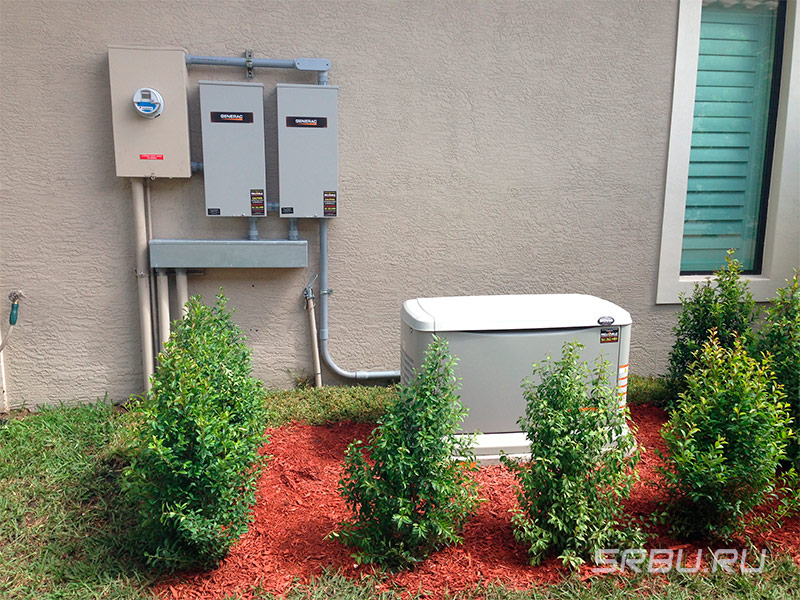
The difference between single and three-phase connection
All connections that are in a single-phase, that in a three-phase network are made completely identical, with the exception of the number of power wires. The only important nuance concerns the so-called control phase - if the starter is connected to the network, its main contacts connect and disconnect the power wires from the network, and the power for the electromagnetic coil must also be taken from somewhere.
There are no problems in a single-phase network - phase one and this question simply does not exist, but in a three-phase network everything is somewhat more complicated - there are L1, L2 and L3. Without going into technical details, the answer here is one - for control circuits, you can use any of the phases, but only one. That is, if the KM1 coil is powered from phase L3, then the control of the other starters, the “Start” and “Stop” buttons also need to be “suspended” only on it. This is not difficult to do - just note what color the wire is at the desired phase, and if the cable is with single-color conductors, then stick or draw markers on them.
Grounding
The principle of operation of the generator assumes the periodic occurrence of static electricity on its casing, therefore all permanently installed devices without fail require a separate ground loop.
The ideal option is to create a full-fledged grounding circuit, but in general you can do it in the simplest way, for which you need a metal rod 1.5-2 meters long, a steel bolt or clamp connection and a soft copper wire. A bolt is welded to the iron rod, and the pin itself is clogged to the ground to its full length. The copper wire is screwed on one side to the bolt (or clamped with a clamp), and the other to the generator housing - grounding is ready.
These are all the main ways to connect a gas generator to the home network and possible nuances. The presented schemes will help determine whether it is worth installing autostart systems or it will be easier to do with manual switching. Of course, when installing each individual generator, an ABP unit or a home-made autostart system, additional questions may arise, but they will have to be solved in each case separately, depending on the model of the device and the circuit of the home electrical network.
Particleboard - what is it, characteristics and composition of the material
Reviews of sofas of various models: user ratings, ratings and opinions
Living room design with fireplace - 47 interiors and photo ideas
Owner reviews about septic tanks Tank, negative and positive points of using models: 1, 2, 3, 4



